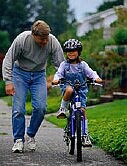Family Exercise Strengthens Bonds as Well as Bodies
 (HealthDay News) � To paraphrase a tried-but-true axiom: The family that plays together stays together. (HealthDay News) � To paraphrase a tried-but-true axiom: The family that plays together stays together.
Exercise may be an ideal therapy for parents who want spend more quality time with the kids, teach them fitness goals that can last a lifetime, and maybe improve their own conditioning in the process.
"If parents are involved with their children in physical activity -- riding bikes, hiking or Rollerblading -- when the kids are young, the children will be more likely to do it for the rest of their lives," says Dr. Eric Small of New York City, an expert in pediatric and adolescent sports medicine. He's also the author of sports and exercise books for children.
And Judy Young, vice president for programs for the American Alliance for Health, Physical Education, Recreation and Dance in Reston, Va., adds her concern about kids not getting enough exercise: "Most kids are not exercising, and parents and kids need to be more intentional about physical activity.
"Sixty percent of all people are not getting the recommended amount of physical activity, and it's probably in the 40-to-60 percent range for children," Young adds."
It's no longer news that a lack of exercise leads to weight problems and is bad for your health. The rate of obesity among American children and adolescents has tripled since 1980, according to the U.S. Department of Health and Human Services. With that rise has come an increase in diseases that until recently were rare in children, including a tripling of type 2 diabetes. Medical research is increasingly showing a direct link between childhood obesity and the onset of diabetes.
Much of the problem can be traced to the conveniences offered by technology; the fact that schools offer less gym time than a generation ago (most elementary schools offer gym classes only two or three days a week, instead of daily); and the lack of unstructured play time for kids. This has all resulted in a far more sedentary lifestyle for most kids, Young says.
That's not to say all children are less active. "There's a group of middle-class families whose children are very involved in sports and physical activity," Young says. But overall, kids just aren't getting enough exercise, she adds.
Small says that even children playing team sports, like baseball and soccer, aren't learning a physical activity -- such as riding a bike -- that they can carry into adulthood.
"Kids often get tired of the sport and quit, and it's not a lifetime sport," he says.
Young says that school-age children, those between 5 and 12 years old, should have a minimum of one hour of moderate and/or rigorous activity every day, in addition to any physical education programs in school. Moderate activity would include bike riding and general outdoor play, while more rigorous pursuits would include running races or longer bike rides, she says.
Even babies need to exercise and have the chance to freely explore the world around them, Young says.
Parents often move their babies from a high chair to a car seat to a "snuggly" or carry them around, out of safety concerns or convenience, she adds. The result: The child is never allowed freedom of movement.
"Babies can have a whole day without moving around, which gets kids established in a very sedentary pattern," she says.
To promote family activities, Small recommends choosing a different activity each weekend, and sticking to a regular routine so the children look forward to doing things with their parents.
Another good idea, Young says: Make sure there are places for kids to play, both indoors and outdoors. "Houses used to have a 'rumpus room' for kids," she says.
Other suggestions:
-
Buy toys that promote physical activity, like balls, bikes and skates.
-
Take a family walk that includes having the kids "find" or count things, like fences, bikes, dogs or houses of certain colors.
-
Go to a driving range, play miniature golf, or fly a kite.
-
Get yourself and your kids outdoors -- just being outside promotes physical activity.
-
Keep a log of the physical activities you've done with your children.
On the Web
The President's Council on Fitness and Sports has a number of excellent publications for the family. This one on exercise and weight control may be especially helpful.
Author: Janice Billingsley, HealthDay Reporter
SOURCES: Eric Small, M.D., assistant professor of pediatrics and orthopedics, Mount Sinai Hospital, New York City, and member, Committee on Sports Medicine and Fitness, American Academy of Pediatrics; Judy Young, Ph.D., vice president for programs, American Alliance for Health, Physical Education, Recreation and Dance, Reston, Va.
Publication date: May 1, 2005
Copyright © 2005 ScoutNews, LLC. All rights reserved.
|



